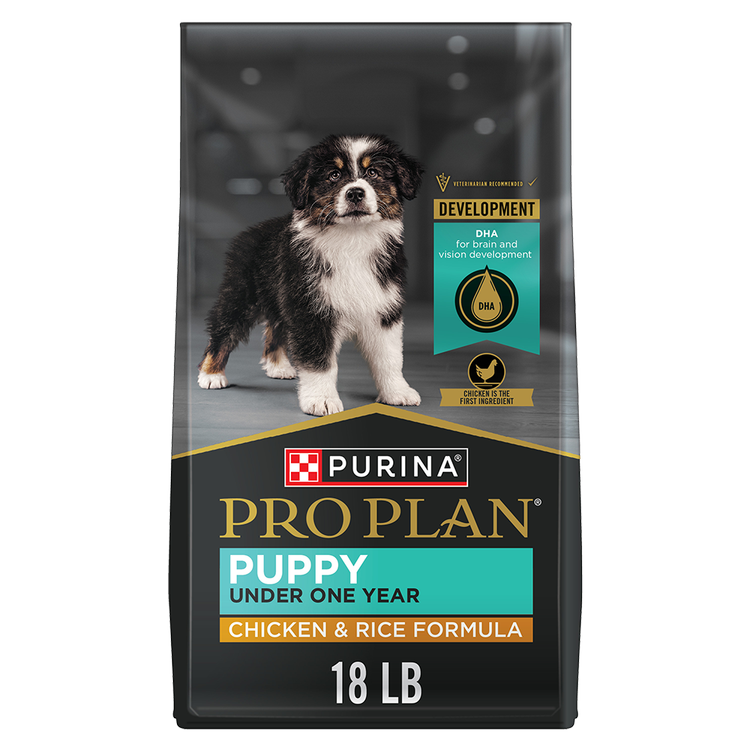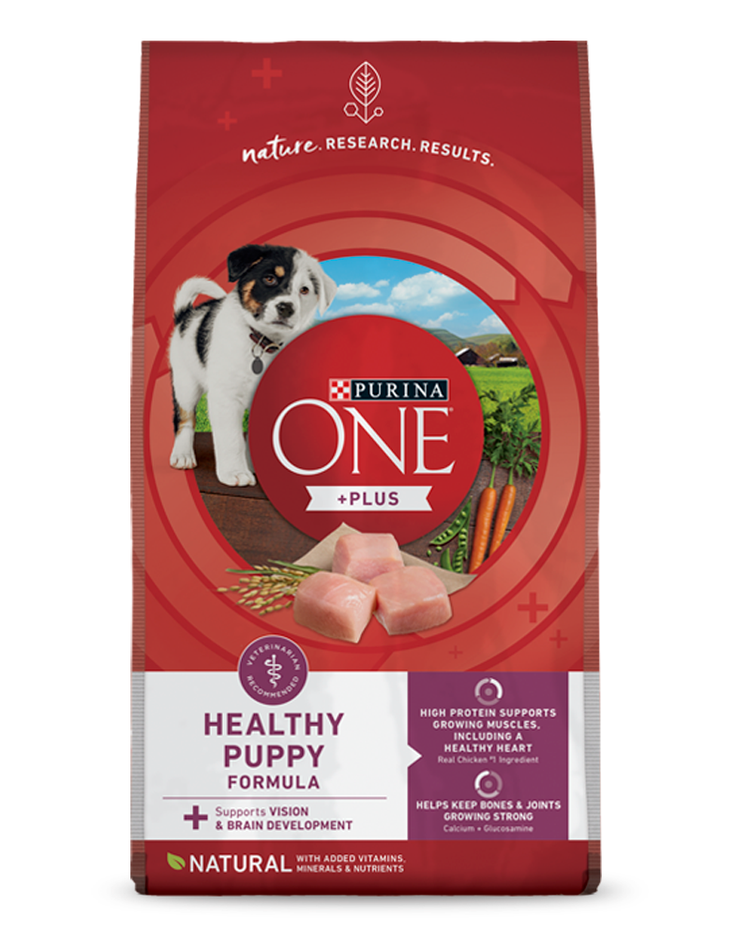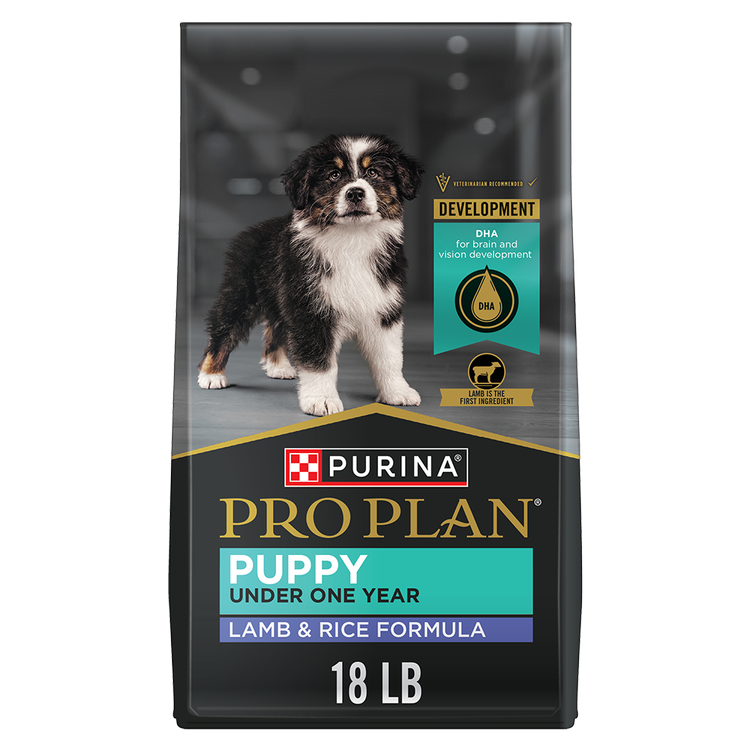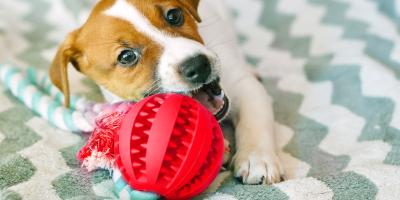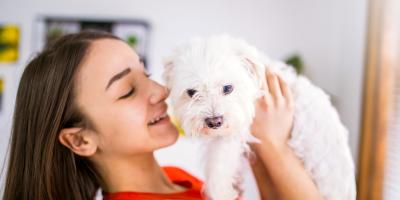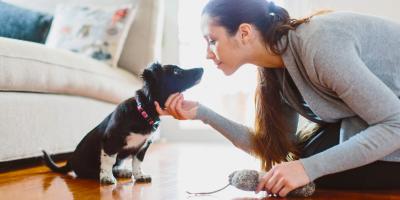Your Puppy’s First Bath: Step-By-Step Instructions


When can puppies have their first bath? It’s a question many dog owners ask as they navigate the responsibility of caring for their young canine companion.
And it’s just one unknown. When your dog is old enough to have a bath, you’re faced with other pressing questions as well: where are you supposed to wash them? And how often should you bathe a puppy anyway?
The good news is a puppy bath can be a straightforward, stress-free experience. Here are some useful tips and step-by-step instructions to help make your puppy’s first bath a success.
When Can Puppies Have Their First Bath?
You can start bathing your puppy around eight weeks of age. Older dogs’ body temperature self-regulates but young puppies don’t have that ability yet.
A puppy less than eight weeks old might get overheated or too cold during the bathing process.
If you’re wondering, When can you give a puppy a bath?, because your pet needs to be washed but isn’t old enough, try wiping them down with a warm, wet cloth instead.
You can bathe your puppy at home or take them to a groomer or a self-wash station. Make sure they’re fully vaccinated prior to visiting a self-wash place. Groomers often have vaccine requirements as well.
How Often Should You Bathe a Puppy?
Bathe your puppy no more than once a month, unless necessary.
Puppies and adult dogs have natural oils in their coat to prevent their fur from getting brittle or damaged, and to keep it soft and silky. Bathing your dog too often can strip away those oils.
How often to bathe a puppy will vary from breed to breed. A long-haired dog breed is likely to get tangled or matted fur if they go too long between baths. Frequency of baths may also change from one season to another.
Puppies are playful, curious explorers. They’re likely to find joy and adventure by splashing in mud puddles or rolling in something smelly.
So, if your curious puppy needs an extra bath every now and then, that’s okay.
What Can I Wash My Puppy With?
If you’re concerned about how your young dog might react to soap in the bath, know that shampooing puppies is safe and appropriate. Just make sure the shampoo is formulated for dogs. Your veterinarian can give you recommendations.
Puppy Bathing Checklist
When giving a puppy a bath for the first time, make sure you have everything you need on hand, including:
- Treats. Use puppy treats to reward them for good behavior and to help them associate bath time with things they love.
- Towel. Depending on the breed and coat of your dog, they may be quick or slow to dry, but either way, you’ll need a towel to dry them off – and maybe another for you.
- Brush. Make sure you choose an appropriate brush based on your dog’s hair (long, short, coarse, etc.). A brush can help remove loose hair and address any tangles.
- Dog shampoo. Choose a shampoo made specifically for dogs, as human shampoo is not suitable for their fur.
- A nonslip mat. This helps keep them secure.
- Hair dryer. Use with caution, as puppies can overheat if you hold the dryer too close or for too long. If the loud noise scares your puppy, try rewarding them with treats so it becomes a positive experience.
- Bathtub, sink or container. Whether you use bathtub, sink or kiddie pool, your puppy will probably splash around or shake water from their fur. So, make sure the surrounding area is suitable for getting wet.
Preparing to Bathe Your Puppy
Here are some considerations to keep in mind before your first puppy bath:
- Start when they’re young (but not too young). Giving baths early in their development gets your puppy used to the routine. However, if you’re wondering, Can you give a 2-week-old puppy a bath?, make sure to wait until your pet is eight weeks of age. If they are too young, they won’t be able to regulate their temperature. They can overheat or get too cold during bath time.
- Gently brush out their coat. Before bathing them, start brushing your puppy slowly, as this can help them relax. Simple movements with an appropriate brush will also remove dirt and debris from their coat, and alleviate matting and knots.
- Pick a spot. Sinks are perfect for bathing small puppies. A hose or kiddie pool in the backyard can work for larger breeds if the outside temperature is warm enough (make sure to check the water temperature before rinsing your pet). Don’t leave a wet puppy unattended, or you may end up mopping the whole house.
- Make it fun. Your puppy is more likely to behave during bath time if they’re having fun. Try tossing their favorite toy into the tub, or just give them lots of love and attention.
How to Bathe a Puppy, Step-By-Step
If you’re curious how to give an 8-week-old puppy a bath, just follow these steps:
- Give plenty of praise and the occasional treat. Bath time should be an enjoyable experience for you and your puppy. A great way to make baths something they look forward to is to give them lots of praise and reward any good behavior with treats.
- Check the water temperature. Prior to putting your puppy in the bath, make sure the water is warm but not hot.
- Scrub gently. Gentle scrubbing will wash and massage your puppy while getting them used to being handled. This is also an excellent time to check their skin. Feel all over for lumps and rough areas and call your veterinarian if you find anything suspicious.
- Avoid washing the face. Even gentle shampoos can irritate sensitive areas on your puppy such as their eyes. Use a damp wash cloth to wipe their face instead.
- Rinse well. Once you’ve massaged a specially formulated puppy shampoo into their coat, rinse them off thoroughly. Just like in humans, leftover shampoo can cause dry, itchy, flaky skin in dogs. Try to avoid getting water in their ears or eyes.
- Prepare for the post-bath shake. Dogs dry themselves quite a bit by shaking. Unfortunately, that can mean your puppy is mostly dry, but everything else is soaked. You can try tossing a towel over them and rubbing them dry before they shake. Using a hair dryer on a warm or cool setting can also help speed up the process. If it’s cold outside, keep them inside until completely dry.
- Treat time. Reward your puppy for a successful bath by offering them a special treat or fun toy.
How to Get Your Puppy Used to the Hair Dryer
If your puppy’s coat is particularly long or thick, they can take a long time to dry. In this case, using a hair dryer might be necessary.
Sometimes, puppies can find hair dryers to be loud, confusing and even a little frightening, so reassure them and reward them for good behavior if they seem to tolerate it well.
To get your puppy used to the hair dryer, introduce it from an early age, initially just using the dryer to make noise in the room, before moving towards your puppy while giving them calm and soothing encouragement.
Make the sessions short at the beginning and have patience as you both are learning in this process/activity.
Can I Shower a Puppy?
As you consider how to give a puppy a bath, you may be wondering if showering them is appropriate. Using a handheld shower head (versus a pitcher or bucket) can work to soak and rinse your dog. To start, select the most gentle setting, so that your puppy can get used to the experience.
Can I Bathe My 2-Month-Old Puppy?
Once your puppy is eight weeks old, you can start giving them a bath. Bathing them prior to two months isn’t recommended due to the early stage of their development.
Want to provide better care for your puppy? Explore more expert tips in our library of puppy health articles.

Be Rewarded for Your Purina Purchases
Earn and redeem points for Purina products with myPurina app.

